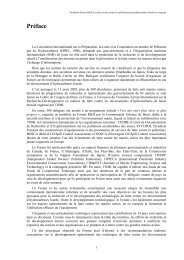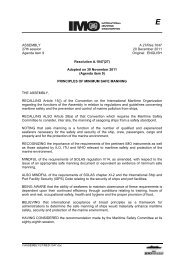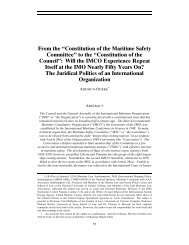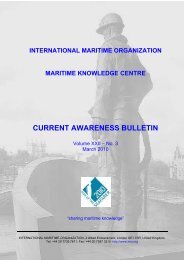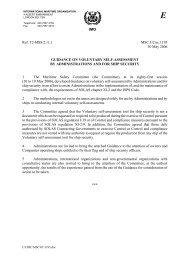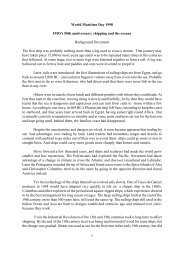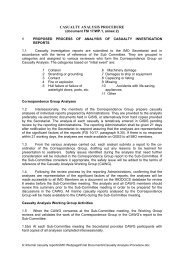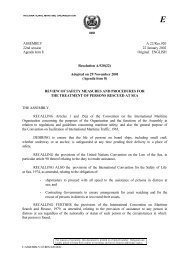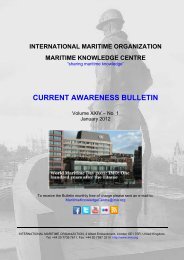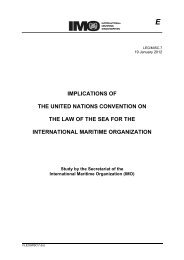Radioactive Waste Disposal at Sea: Public Ideas ... - IMO
Radioactive Waste Disposal at Sea: Public Ideas ... - IMO
Radioactive Waste Disposal at Sea: Public Ideas ... - IMO
You also want an ePaper? Increase the reach of your titles
YUMPU automatically turns print PDFs into web optimized ePapers that Google loves.
Introduction 11<br />
broad range of nonst<strong>at</strong>e actors, including prominent individual scientists<br />
and ecologists, specialized organiz<strong>at</strong>ions of the United N<strong>at</strong>ions, and the<br />
intern<strong>at</strong>ional mass media, framed the issue of ocean dumping, placed it on<br />
the global agenda, and mobilized intern<strong>at</strong>ional political and public support<br />
for the global ocean dumping regime. As a result, the “dying oceans” idea<br />
became institutionalized in the form of the global ocean dumping regime.<br />
More analytically, my case study shows th<strong>at</strong> a loosely organized transn<strong>at</strong>ional<br />
coalition of policy entrepreneurs, consisting primarily of environmentalists,<br />
politicians, and n<strong>at</strong>ional and intern<strong>at</strong>ional government officials,<br />
is able to build an environmental regime by constructing a seemingly evident<br />
and indisputable need for environmental cooper<strong>at</strong>ion. The influence<br />
of transn<strong>at</strong>ional coalitions of policy entrepreneurs stems from their ability<br />
to politically construct intern<strong>at</strong>ional environmental problems and to act as<br />
intern<strong>at</strong>ional norm setters. In brief, they control the process of intern<strong>at</strong>ional<br />
problem definition. To <strong>at</strong>tract political <strong>at</strong>tention, mobilize intern<strong>at</strong>ional<br />
public opinion, and build public pressure, and <strong>at</strong> the same time delegitimize<br />
competing problem definitions and neutralize blocking coalitions, transn<strong>at</strong>ional<br />
coalitions of policy entrepreneurs use global channels of mass<br />
communic<strong>at</strong>ion to spread public ideas, metaphors, and slogans th<strong>at</strong> dram<strong>at</strong>ically<br />
and powerfully capture targeted environmental problems. Using<br />
scientific evidence of environmental damage to persuade policy makers is<br />
not a necessary component of these coalitions’ str<strong>at</strong>egy for influence.<br />
Transn<strong>at</strong>ional coalitions of policy entrepreneurs <strong>at</strong>tempt to cre<strong>at</strong>e fair and<br />
flexible institutional solutions th<strong>at</strong> will increase the particip<strong>at</strong>ion of governments<br />
in regimes.<br />
Persuasive and credible demonstr<strong>at</strong>ion of a need for intern<strong>at</strong>ional environmental<br />
protection is critical in the problem-definition and agenda-form<strong>at</strong>ion<br />
stages of regime form<strong>at</strong>ion. Powerful public ideas and symbols of<br />
environmental destruction are necessary to focus public and political <strong>at</strong>tention<br />
on global environmental problems. Transn<strong>at</strong>ional coalitions of policy<br />
entrepreneurs deliber<strong>at</strong>ely frame and push simple descriptions of targeted<br />
environmental problems in order to mobilize broad support during the<br />
problem-definition stage. Policy entrepreneurs use triggering problems or<br />
focusing events such as perceived ecological c<strong>at</strong>astrophes and environmental<br />
disasters to document the need for environmental policy, to build<br />
public support for environmental policy, and to justify government involvement.<br />
21 Environmentalists, scientists, and mass media are important in




